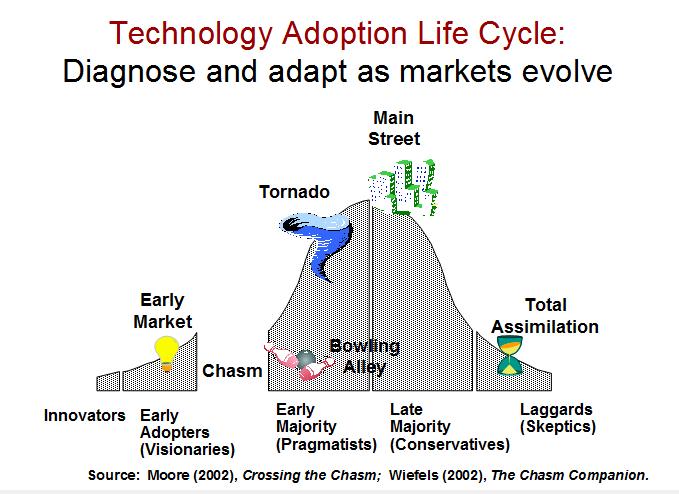In order to do that, first let me explain the model in my own words for those who aren't familiar with it.
The tech adoption life cycle pictured above shows five distinct categories of buyers or groups who accept a new product or technology. The first is the innovators. These are typically the engineers or techie type people who like stuff just because its new and cool. They don't really push the product into market, they just get it for themselves. Think of your friend that is the first in line at the newest iPhone release.
The second group is the early adopters. They are the visionaries: people who see real value in a new technology and want to exploit it. They usually have some money to put into the project. Some of their key characteristics are that they are grabbing up a new product before it is fully usable. They take a product that is, say, 80% complete and tell the inventor "We will work together to put together the last 20%." These early developers are risk takers and go in not fully knowing what the product is really capable of, but they know it has potential. They usually think, "Wouldn't it be nice if everyone had this technology, the world would be so much better or more efficient" etc. Typically they are a fairly small group in comparison to the market.
The third group is the early majority, also known as the pragmatists. To be sure I looked up what exactly pragmatism means from a dictionary standpoint. From m-w.com:
Pragmatism: a practical approach to problems and affairs
The last two groups are the late majority and the skeptics. The late majority, or the conservatives, only accept the product when it looks like they will be left behind if they don't. The skeptics rarely end up accepting the innovation, and if they do, they do so reluctantly.
The Chasm is the space between the visionaries and the pragmatists. There are some personality type issues that come into play which create this void, but I won't talk about those now. The bowling alley is a concept that will apply to to Product Development program strategy I will recommend later, but I won't talk about that now either.
